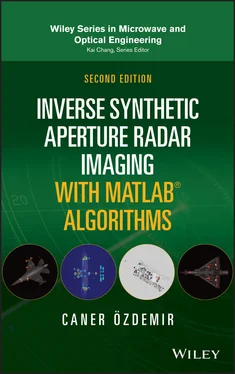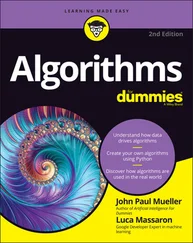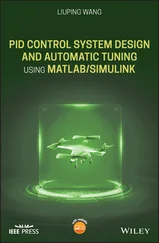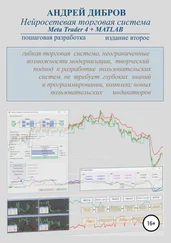642 631
643 632
644 633
645 634
646 b1
647 b2
648 b3
649 b4
650 b5
651 635
Wiley Series in Microwave and Optical Engineering
Kai Chang, Editor
Texas A&M University
A complete list of the titles in this series appears at the end of this volume.
Inverse Synthetic Aperture Radar Imaging with MATLAB Algorithms
With Advanced SAR/ISAR Imaging Concepts, Algorithms, and MATLAB Codes
Second Edition
Caner Özdemir, Phd
Mersin UniversityMersin, Turkey

This second edition first published 2021
© 2021 John Wiley & Sons, Inc.
Edition History John Wiley & Sons, Inc. (1e, 2012)
All rights reserved. No part of this publication may be reproduced, stored in a retrieval system, or transmitted, in any form or by any means, electronic, mechanical, photocopying, recording or otherwise, except as permitted by law. Advice on how to obtain permission to reuse material from this title is available at http://www.wiley.com/go/permissions.
The right of Caner Özdemir to be identified as the author of this work has been asserted in accordance with law.
Registered Office John Wiley & Sons, Inc., 111 River Street, Hoboken, NJ 07030, USA
Editorial Office 111 River Street, Hoboken, NJ 07030, USA
For details of our global editorial offices, customer services, and more information about Wiley products visit us at www.wiley.com.
Wiley also publishes its books in a variety of electronic formats and by print‐on‐demand. Some content that appears in standard print versions of this book may not be available in other formats.
Limit of Liability/Disclaimer of Warranty MATLAB® is a trademark of The MathWorks, Inc. and is used with permission. The MathWorks does not warrant the accuracy of the text or exercises in this book. This work’s use or discussion of MATLAB® software or related products does not constitute endorsement or sponsorship by The MathWorks of a particular pedagogical approach or particular use of the MATLAB® software. While the publisher and authors have used their best efforts in preparing this work, they make no representations or warranties with respect to the accuracy or completeness of the contents of this work and specifically disclaim all warranties, including without limitation any implied warranties of merchantability or fitness for a particular purpose. No warranty may be created or extended by sales representatives, written sales materials or promotional statements for this work. The fact that an organization, website, or product is referred to in this work as a citation and/or potential source of further information does not mean that the publisher and authors endorse the information or services the organization, website, or product may provide or recommendations it may make. This work is sold with the understanding that the publisher is not engaged in rendering professional services. The advice and strategies contained herein may not be suitable for your situation. You should consult with a specialist where appropriate. Further, readers should be aware that websites listed in this work may have changed or disappeared between when this work was written and when it is read. Neither the publisher nor authors shall be liable for any loss of profit or any other commercial damages, including but not limited to special, incidental, consequential, or other damages.
Library of Congress Cataloging‐in‐Publication Data
Names: Özdemir, Caner, author.
Title: Inverse synthetic aperture radar imaging with MATLAB algorithms: with advanced sar/isar imaging concepts, algorithms, and matlab codes / Caner Ozdemir, PhD Mersin University, Mersin, Turkey.
Description: 2nd edition. | Hoboken, NJ, USA : Wiley, 2021. | Series: Wiley series in microwave and optical engineering | Includes bibliographical references and index.
Identifiers: LCCN 2020031216 (print) | LCCN 2020031217 (ebook) | ISBN 9781119521334 (cloth) | ISBN 9781119521365 (adobe pdf) | ISBN 9781119521389 (epub)
Subjects: LCSH: MATLAB. | Synthetic aperture radar. | MATLAB.
Classification: LCC TK6592.S95 O93 2020 (print) | LCC TK6592.S95 (ebook) | DDC 621.3848/5–dc23
LC record available at https://lccn.loc.gov/2020031216LC ebook record available at https://lccn.loc.gov/2020031217
Cover design by Wiley
Cover image: Courtesy of Caner Özdemir, (background) © Maxiphoto/Getty Images
To:My wife Betül,My three daughters,My brother,My father,and the memory of my beloved mother
Preface to the Second Edition
In the first edition of the book, I tried to cover most of the aspects of inverse synthetic aperture radar (ISAR) imaging starting from Fourier analysis to some advanced ISAR concepts such as range‐Doppler ISAR processing and ISAR motion compensation techniques. The main goal was to present a conceptual description of ISAR imagery and the explanation of basic ISAR research topics. Although the primary audience would be graduate students and other interested researchers in the fields of electrical engineering and physics, I hoped that colleagues working in radar research and development or in a related industry might also benefit from the book.
It has been more than eight years since the publication of the first edition. Since then, I have been really grateful that I have received positive responses from the researchers and colleagues that are interested and/or involved in radar imaging, and especially ISAR imaging. Undoubtedly, ISAR has been gaining more attention among researchers, scholars, and engineers as emerging new developments in ISAR research have been reported by various colleagues day by day.
In this second edition of the book, I have tried to include the recent progress made in ISAR imaging research and also give insights to more advanced concepts. Therefore, in this edition of the book, I have made the following alterations and additions:
All the chapters in the first edition have been revised including all the texts, equations, and figures with some additions. Typos in the first edition have also been corrected.
Chapter 3that is devoted to the issues of synthetic aperture radar (SAR) has been extended to include the SAR focusing/processing algorithms such as range‐Doppler algorithm (RDA), back‐projection algorithm (BPA) and frequency‐wave number algorithm (ω‐kA). The Matlab codes for these algorithms are being provided with the associated numerical examples. Brief explanations of other SAR focusing/processing algorithms including chirp scaling algorithm (CSA) and phase shift algorithm (PSA) have also been mentioned.
In Chapters 4, 5, 7, and 12where we handle various aspects of ISAR imaging technology, new scattered field raw data and the corresponding ISAR images that are more visually attractive are presented together with the associated Matlab codes that can be used to generate these images.
A total of three new chapters have been written to cover the topics that were not considered in the first edition and also to include more detailed subjects of ISAR imaging to be able to reflect the recent research studies. These are listed below:The “Bistatic ISAR (Bi‐ISAR) Imaging” concept is covered in Chapter 9. While the ISAR imaging algorithms presented in previous chapters are based on monostatic usage of ISAR imaging, we introduce the formulation of ISAR imaging for the bistatic usages by presenting key aspects such as resolutions in range/cross‐range directions and usage limitations. Also, extension of Bi‐ISAR to multistatic ISAR (Mu‐ISAR) imaging is derived with the associated Matlab examples. A general assessment of Bi‐ISAR and Mu‐ISAR imaging to conventional monostatic ISAR imaging is being made throughout the chapter by comparing the outcomes of quantitative metrics and giving the concluding statements about their advantages and disadvantages based on these measurable evaluations.In Chapter 10, we have added a new and exciting research topic of ISAR called “Polarimetric ISAR Imaging.” As the traditional ISAR imaging algorithms are based only on a single polarization of the backscattered electric field, we demonstrate in this chapter that very exciting features of the target can be extracted with the use of other possible polarizations for the reflected wave. Polarization decomposition techniques are being introduced and Pauli decomposition scheme is taken as the tool to be applied to the different polarization ISAR images in this book. The formulation and the usage of Pauli decomposition technique are presented together with its Matlab codes. Various realistic simulation examples based on linear polarization, circular polarization, and also Pauli decomposition are given together with obtained polarimetric ISAR images. It has been demonstrated through the examples that polarized ISAR images definitely increase the recognition and classification of targets by providing increased number of extracted target features.Thanks to the recent development in the microwave circuit technology and antenna design, ISAR imaging algorithms have been started to be used in the near‐field region. Therefore, I have added a new part entitled “Near‐field ISAR imaging” as Chapter 11. The near‐field ISAR imaging algorithms are being introduced. Two of them called “Focusing operator” and the back‐projection based focusing algorithms are given by presenting their theoretical formulation and algorithm steps together with corresponding Matlab codes. Also, numerical and measured examples based on real scenarios are being shared.
Читать дальше













